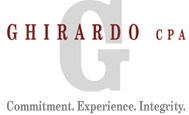Tax Savings for 2009
/Following is a quick run down of 10 important tax savings available on the 2009 Form 1040. However, many of the tax savings come with limitations, so if you have any questions about these changes, please don’t hesitate to contact your Ghirardo CPA tax professional. 1. AMT exemption. The maximum alternative minimum tax (AMT) exemption has increased to $70,950 from $69,950 for married filing joint filers and surviving spouses, $46,700 from $46,200 for unmarried individuals, and $35,475 from $34,975 for married individuals filing separately in 2009.
2. Child tax credit. The child tax credit remains the same at $1,000 for each qualifying dependent child under age 17, however the refundable portion of the credit has increased to 15% of earned income in excess of $3,000 as opposed to 15% of earned income above $8,500.
3. College expenses tax credit. The Hope Scholarship credit has been expanded and renamed the American Opportunity Credit. Currently, the maximum credit is expanded to $2,500 from $1,800 and the credit is allowed for the first four years rather than only two years of post-secondary education. The modified adjusted gross income range for phase out of the credit is increased from $80,000 to $90,000 for individuals and from $160,000 to $180,000 for joint filers.
4. Personal energy property credit. Make energy-efficient home improvements and you can claim up to $1,500. The credit is calculated as 30% of the purchase price, subject to the $1,500 credit limit, for qualifying solar heating, insulation, windows, doors, roofs, heat pumps, hot water heaters, or boilers. This credit can also be used against AMT!
5. Homebuyer credit. You’ve probably already heard about the First-Time Homebuyer Credit which gives a tax credit of $8,000 towards the purchase of your home if you don't already own one. The extension bill (which extended the program through April 30, 2010) also included a provision for some current homeowners to be eligible for a $6,500 credit on the purchase of a new home.
6. Kiddie tax threshold. The “kiddie tax” rules generally tax excess investment income of those under age 19, or under age 24 at the end of 2009, if full-time students, at their parents’ highest marginal tax rate. For 2009, the threshold to which these rules apply is unearned income in excess of $1,900.
7. Making work pay credit. In 2009 the new making work pay credit reduces tax liability by up to $400 per person (up to $800 per couple on a joint return). However, watch out for the eligibility rules, as some people whose withholding was reduced are not actually eligible for the credit due to phase out in the modified adjusted gross income range of $75,000 to $95,000 per persona and $150,000 to $190,000 per couple.
8. Motor vehicle sales tax. Sales tax paid on the purchase of a new motor vehicle from February 17 through December 31, 2009 is deductible, whether you itemize your deductions or not. The deduction is limited to the tax on up to $49,500 of the vehicle’s purchase price, and the deduction phases out for a taxpayer with modified adjusted gross income between $125,000 and $135,000 and $250,000 and $260,000 on a joint return.
9. Standard deduction. The basic standard deduction amounts are $11,400 for joint return filers and surviving spouses, $8,350 for heads of households, and $5,700 for others in 2009, an increase from $10,900, $8,000, and $5,450, respectively, in 2008. So, for some individuals who itemized deductions in prior years, it may be more beneficial to claim the standard deduction for 2009.
10. Unemployment compensation. Up to $2,400 of unemployment compensation benefits per person are completely tax-free in 2009. These benefits are not included in your adjusted gross income, so could help you to qualify for other tax benefits that have AGI restrictions.



